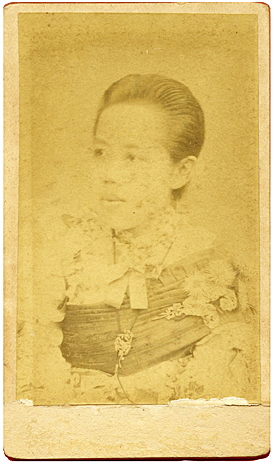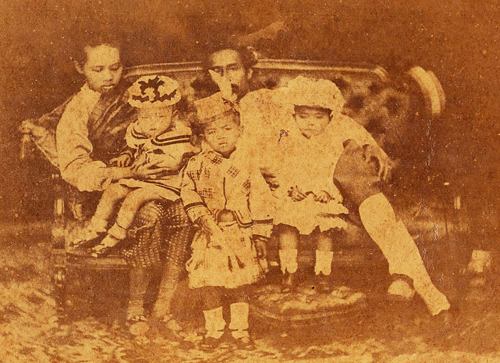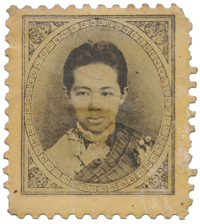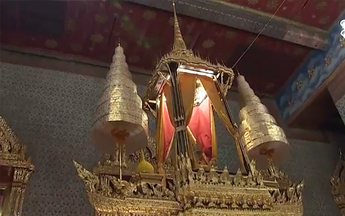

| THAILAND'S FORGOTTEN QUEEN |
On 20 November 2013, the Prime Minister announced that UNESCO has included Her Majesty Queen Sri Bajarindra on the list of Anniversaries of historic events and of eminent personalities celebrated by Member States and Associate Members with which UNESCO is associated in 2014-2015. Thailand celebrates the 150th Anniversary of the Birthday of Her Majesty on 1 January 2014.
20 November 2019 marks the Centenary of the passing of Her Majesty Queen Sri Bajarindra the Queen Regent. Her great-granddaughter, Mom Rajawongse Narisa Chakrabongse, owner of River Books, is publishing a commemorative book on the Forgotten Queen. Luckily, she was not completely forgotten in the Tenth Reign, with a Buddhist Ceremony to mark the event at the Amarindra Throne Hall, The Grand Palace.

 |
 |
 |
 |
| HRH the Princess Consort Piyamavadi with Prince Unagan |
Her Majesty Queen Sri Bajarindra was born Her Royal Highness Princess Saovabha Phongsri on 1 January 1864, to His Majesty King Mongkut (Rama IV) and the Princess Consort Piyamavadi of the Aristocratic Sucharitkul family. Her siblings were:
| 1. | HRH Prince Unagan Anantanorachai 22.2.1856-29.3.1873 (17) |
| 2. | HRH Prince Devan Uthayavongse, The Prince Devavongse Varoprakarn 27.11.1858-28.6.1923 (64) |
| 3. | HRH Princess Sunanda Kumariratana, who later became HM Queen Sunanda Kumariratana 10.11.1860-31.5.1880 (19) |
| 4. | HRH Princess Savang Vadhana, who later became HM Queen Sri Savarindira 10.9.1862-17.12.1955 (93) |
| 5. | Queen Sri Bajarindra |
| 6. | HRH Prince Svasti Sobhon, The Prince Svastivadanavisith 22.12.1865-10.12.1935 (70) |
 |
| Queen Sri Bajarindra and King Chulalongkorn with 3 of their eldest children |
King Chulalongkorn and Queen Sri Bajarindra had 7 sons and 2 daughters, with only 5 sons survived to adulthood.
| 1. | HRH Princess Bahurad Manimaya 27.6.1878-27.8.1887 (9) |
| 2. | HM King Vajiravudh (Rama VI) 1.1.1881-26.11.1925 (44) |
| 3. | HRH Prince Tribej Rutamadhamrong 8.2.1882-22.11.1887 (5) |
| 4. | HRH Prince Chakrabongse Bhuvanath 3.3.1883-13.6.1920 (37) |
| 5. | HRH Prince Siriraj Kakudhabhandha 27.11.1885-31.5.1887 (1) |
| 6. | HRH Princess (Not yet named, died at birth) 13.12.1887 |
| 7. | HRH Prince Asdang Dejavudh 12.5.1889-9.2.1925 (35) |
| 8. | HRH Prince Chudadhuj Dharadilok 5.7.1892-8.7.1923 (31) |
| 9. | HM King Prajadhipok (Rama VII) 8.11.1893-30.5.1941 (47) |
 |
At left is a picture of the Queen taken with her surviving immediate family at King Chulalongkorn's funeral. Standing from left to right are Prince Asdang, King Vajiravudh and Prince Chakrabongse. Seated on the floor from left to right are Prince Chudadhuj, her first grandson Prince Chula Chakrabongse, and the future King Prajadhipok. |
 |
Queen Sri Bajarindra's Regency Council Prince Naris worte that the Queen Regent took the her given role very seriously, and was extremely careful with all decision makings. She made sure to understand every angle of any issue before she chose what would be the best solution. She was equal if not better than many men of her days. She did not wince at any job that a man could do, and went about her business with gusto. |
During Her Majesty’s Regency, her team consisted of:
| 1. | HRH Prince Chaturonrasmi, The Prince Chakrapadipongse, the King’s younger brother |
| 2. | HRH Prince Bhanurangsri Savangwongse, The Prince Bhanubhandhuvongse Voradej, the King’s younger brother |
| 3. | HRH Prince Devan Uthayavongse, The Prince Devavongse Varoprakarn, the King’s younger half-brother, and the Queen’s older brother |
| 4. | HRH Prince Prince Ditsawarakuman, The Prince Damrong Rajanubhab, the King’s younger half-brother |
| 5. | HE Chao Phraya Abhairaja (Gustave Henri Ange Hippolyte Rolin-Jacquemyns), the King’s advisor who was the Belgian Minister of Interior |
| 6. | HRH Prince Pravitra, Prince of Prajin, the King’s son, as Principle Secretary |
Her Majesty the Queen Regent was the first woman of Siam to oversee the betterment of the Siamese women, first making herself a teacher to the Court of King Chulalongkorn, teaching the ladies the proper ways and educating them about Siamese ceremonies and culture.
King Chulalongkorn first thought of establishing a hospital in 1886, and the Siriraj Hospital was set up on 26 April 1888, in which the Queen contributed a large sum, and naming it after their son, Prince Siriraj Kakudhabhandha, who has died in 1887, not yet 2 years of age. Also in 1888, the Queen set up a nursing school that also specialized in pregnancy care, thereby becoming the first nursing school in Thailand that has since became the nursing faculty of Mahidol University. During the spat between Siam and France in 1893 which resulted in many wounded soldiers, doctors from Siriraj were sent to help, and the Queen herself went to visit, becoming the first Siamese Queen to do so. She said to the soldiers,
 |
There was only one school for girls in Siam at the time, set up by an American missionary, which lacked the education on Siamese culture and history. She thus set up the first Siamese school for girls in 1901, named it Satri Bumroong Vicha. In 1904, she set up the Sunantalai School for children of persons of the Royal Court, teaching manners, household care and social works, paying the teachers wages and all other expenses from her own privy purse. The school evolved into the Rajini School, the first proper school for girls in Thailand. |
| Above: Rajini School today |
| As Queen Regent, and Rama V’s principle Queen per her eldest son’s position as Crown Prince of Siam, she still regarded her elder sister, Queen Sri Savarindira as the most senior female member of the Royal Family, thus always took the care to walk a few steps behind her elder sister in all Court Ceremonies and functions, an action that was both proper, considerate and just plain nice, true to the traditions and culture of Siam. It was an act of respect, universally understood in all cultures, especially in Asia. |  |
| Above: Queen Sri Savarindira or Queen Savang with her surviving children; Princess Valaya Alongkorn and Prince Mahidol, King Bhumibol's father | |
Right: A postcard featuring King Chulalongkorn at centre, Queen Sri Bajarindra on the left, and Crown Prince Maha Vajiravudh (later King Rama VI) on the right, complete with original stamp of King Chulalongkorn, postmarked 1905. Below: Queen Sri Bajarindra Stamp, used within the Royal Palace, circa 1890s |
 |
 |
After the King passed away in 1910, the Queen became the Queen Mother of King Rama VI, continued her social works in opening many more schools around the country including the Vichiaramartu School in Trang Province, again with funds from her privy purse and the Rajini Burana, giving both land and funding. Her interests included agriculture, and part of the land of her Phyathai Palace was used for agricultural experiments growing plants as well as different species of rice, and livestocks. In addition, the Queen Mother represented her son, King Vajiravudh, on a few foreign visits, notably to the neighbouring countries and to Hong Kong. |
Queen Sri Bajarindra's Indochina Visit, 1912 |
 |
Her Majesty passed away on 20 October 1919, in the reign of her eldest son, King Vajiravudh or Rama VI, at the age of 55. Her youngest son would also become King, Prajadhipok, or Rama VII, who granted democracy in 1932 before abdicating a few years later, as he did not believe the new government was looking out for the population as they have promised to do. Her elder sister, Queen Sri Savarindira, or Queen Savang as commonly known nowadays, would outlive her for another 36 years. She also got to witness two World Wars, the many changes within her beloved Kingdom, many more heartaches under dictatorial rules and corruptions under the banner of democracy, of how the peaceful Siam of old has tuned into a contradicting country with power-hungry personage vying to run the show. |
Queen Sri Savarindhira or Queen Savang Vadhana was mother to 4 sons and 4 daughters, namely:
| 1. | HRH Crown Prince Maha Vajirunhis 26.7.1878-4.1.1895 (16), Siam’s first Crown Prince |
| 2. | HRH Prince Isariyalongkorn 4.9.1879-25.9.1879 (21 days) |
| 3. | HRH Princess Vichitra Chiraprabha 21.4.1881-15.8.1881 (3 months) |
| 4. | HRH Prince Sommatiwongse Varodaya 9.6.1882-17.6.1899 (17) |
| 5. | HRH Princess Valaya Alongkorn 16.4.1884-15.2.1939 (54) |
| 6. | HRH Princess Sirabhorn Sobhon 19.7.1888-28.5.1898 (9) |
| 7. | HRH Prince Mahidol Adulyadej 1.1.1892-24.9.1929 (37), father of Thailand’s present King Bhumibol Adulyadej, or Rama IX |
| 8. | HRH Princess (Not yet named, died a week after birth) 9.11.1893 (7 days) |
Her Majesty Queen Sri Savarindira passed away on 17 December 1955 at 93 years old, making her the last of Rama V’s Queen Consorts, having survived all of her siblings, her husband as well as all of her own children and all of her sisters’ children. She also lived under 25 Prime Ministers of Thailand in the span of just 23 years in the so-called new era after the change from absolute monarchy to democracy. It was known that during the last years of Queen Savang’s life, during her spats of forgetfulness that is common with old age, she would call out to her younger sister to come and join her for lunch and dinner.
It should be noted that with all the changes that affected the Kingdom, which in turn directly affected her life, Queen Savang never once uttered a word. In this day and age, one’s life is not at all affected in the same manner, but with just a small mishap in politics, the minority would come out and shout obscenity while misunderstanding their own beliefs.
Queen Savang was listed in the UNESCO Calendar of Anniversaries of Great Personalities and Historic Events, 2012-2013, on her 150th anniversary in 2012.
Poignantly, her beloved sister, Her Majesty Queen Regent Sri Bajarindra has been listed in the UNESCO Calendar of Anniversaries of Great Personalities and Historic Events, 2014-2015, also on her 150th anniversary in 2014.
| Thailand's Forgotten Queen? | |
 |
Now, why is Queen Sri Bajarindra Thailand's Forgotten Queen? The Thai people in general are not really interested in Thailand's history per say. With His Majesty the King being The King, a lot of emphasis has been put on Queen Savang being the King's grandmother. The sad part is that she has been credited with her sister's accomplishment as well, leaving the First Queen Regent by the way side, so to speak. Thanks to the Rajini School's current Principle, Mom Luang Pratintip Nakornsup of the Royal House of Devakul, descendants of Prince Devan, the Regent Queen's older brother, who did all the hard work in requesting UNESCO to acknowledge the Queen Regent, and she has since been brought to light. The King has acknowledged his great-aunt, and the government has also jumped on the bandwagon. But due to Thailand's current political turmoil, the Queen Regent is again put in a dark spot....but not on these pages. She will be remembered as a Great Queen of Thailand who did so much to advance Thai women's education, education in medicine and social works, building a solid base for future generations to continue to build upon. |
| The Royal Ceremony to mark the Centenary of the Passing of HM Queen Sri Bajarindra, The Queen Regent, on 20 October 2019, at the Amarindra Vinichai Throne Hall, The Grand Palace, Bangkok. | |
 |
 |
 |
 |
 |
|
| At the Centenary Ceremony, Somdetch Pra Maha Virawongse, the revered monk at Raj Bopit Temple gave a moving sermon, informing everyone about the Queen Regent. It was a well researched speech full of small anecdotes, uplifting stories, and facts about the Queen that many have forgotten. As she hasn't been much mentioned in the last reign, and the history books concentrated more on her sister, Queen Savang, most Thais have forgotten her. It is nice to hear her being mentioned again in all of her glory. The Royal Urn containing her ashes is normally stored at the top of the Dusit Maha Prasat Throne Hall, The Grand Palace, was solely brought down for the celebrations of her life on this 100th anniversary of her death. It was indeed a lovely and grand gesture, befitting one of the most imporant figures in Thailand's long history. | |
| VIEW FAMILY TREE |
| SIAMESE COLLECTION | SIAMESE ROYALTY |
